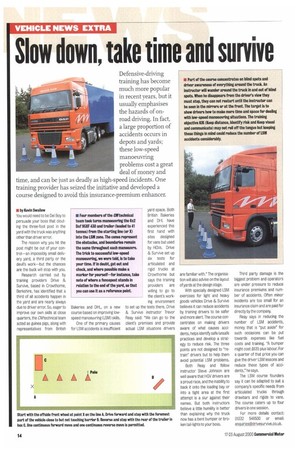• by Kevin Swallow You would need to be Del
Page 16

If you've noticed an error in this article please click here to report it so we can fix it.
Boy to persuade your boss that clouting the three-foot post in the yard with the truck was anything other than driver error.
The reason why you hit the post might be out of your control—an impossibly small delivery yard, a third party or the devil's work—but the chances are the buck will stop with you.
Research carried out by training providers Drive & Survive, based in Crowthorne, Berkshire, has identified that a third of all accidents happen in the yard and are nearly always due to driver error. So, eager to improve our own skills at close quarters, the CMtechnical team acted as guinea pigs, along with representatives from British Bakeries and DHL, on a new course based an improving lowspeed manoeuvring (LSM) skills.
One of the primary causes for LSM accidents is insufficient yard space. Both British Bakeries and DHL have experienced this first hand with sites designed for vans but used by HGVs. Drive & Survive set up six tests for articulated and rigid trucks at Crowthorne but says the training providers are willing to go to the client's working environment to set up the tests there. Drive & Survive instructor Trevor Reay said: "We can go to the client's premises and provide actual LSM situations drivers are familiar with." The organisation will also advise on the layout of yards at the design stage.
With specially designed LSM exercises for light and heavy goods vehicles Drive & Survive believes it can reduce accidents by training drivers to be safer and more alert. The course concentrates on making drivers aware of what causes accidents, helps identify safe/unsafe practices and develop a strategy to reduce risk. The three points are not designed to "retrain" drivers but to help them avoid potential LSM problems.
Both Reay and fellow instructor Steve Johnson are well aware that HGV drivers are a proud race, and the inability to back it onto the loading bay or into a tight area at the first attempt is a slur against their names. But both instructors believe a little humility is better than explaining why the truck now has a bent bumper or broken tail-lights to your boss. Third party damage is the biggest problem and operators are under pressure to reduce insurance premiums and number of accidents. Often minor incidents are too small for an insurance claim and are paid for directly by the company.
Reay says in reducing the number of LSM accidents, money that is "put aside" for such occasions can be put towards expenses like fuel costs and training. "A bumper might cost 1635 plus labour. For a quarter of that price you can give the driver LSM lessons and reduce these types of accidents," he says.
The LSM course founders say it can be adapted to suit a company's specific needs from articulated trucks through drawbars and rigids to vans. The course caters up to four drivers in one session.
For morn details contact: 01332 546500 or email: enquiriesPdrivesurvive.co.uk.




































































































